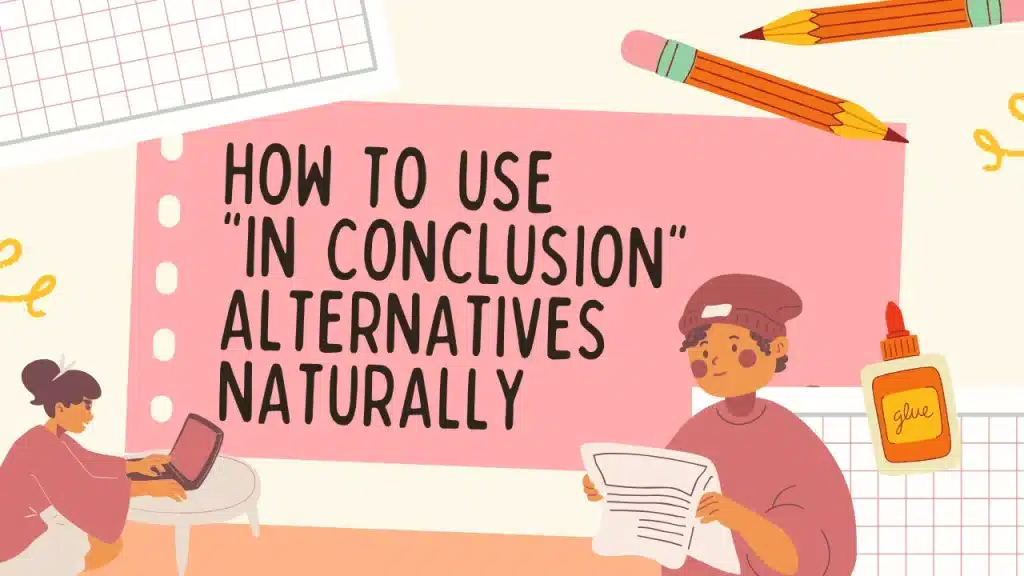Every writer, student, or public speaker eventually faces the challenge of wrapping up their content neatly. Whether you’re closing an essay, ending a speech, or summarizing key points in a blog post, using the phrase “in conclusion” repeatedly can feel repetitive. While this phrase is widely accepted, it can quickly become boring or overused. So, what are some other ways to say in conclusion that still feel clear, polished, and professional?
In this article, we’ll dive into several smart alternatives that will help you sound more natural and engaging while still getting your point across effectively.
Read more about: 20 other ways to say happy valentine’s day
20 Other Ways to Say in Conclusion
- To sum up
- In summary
- To conclude
- All in all
- In closing
- To wrap up
- Ultimately
- In brief
- In final analysis
- As a final point
- At the end of the day
- To bring it all together
- Final thoughts
- In short
- In essence
- Overall
- On the whole
- Last but not least
- Summing it all up
- Let’s conclude with this
1. To sum up
To sum up, regular exercise improves mental health, boosts energy, and supports a longer life.
2. In summary
In summary, electric cars offer a cleaner, quieter, and more efficient mode of transportation.
3. To conclude
To conclude, education remains the most powerful tool for breaking the cycle of poverty.
4. All in all
All in all, the event was a huge success despite the initial weather challenges.
5. In closing
In closing, I encourage everyone to take small steps daily toward a healthier lifestyle.
6. To wrap up
To wrap up, , communication, and planning are key to any successful project.
7. Ultimately
Ultimately, our choices today will shape the future of the planet.
8. In brief
In brief, the study proves that sleep quality strongly impacts academic performance.
9. In final analysis
In final analysis, the new policy benefits both employees and the company long-term.
10. As a final point
As a final point, let’s remember the importance of kindness in building strong communities.
11. At the end of the day
At the end of the day, happiness comes from within, not from material things.
12. To bring it all together
To bring it all together, we’ve seen how technology reshapes business, education, and daily life.
13. Final thoughts
Final thoughts: practice, patience, and persistence are the keys to mastering any skill.
14. In short
In short, pollution harms our health, our economy, and our environment.
15. In essence
In essence, the film is about resilience, love, and the power of the human spirit.
16. Overall
Overall, the feedback from our clients has been overwhelmingly positive.
17. On the whole
On the whole, the training program exceeded expectations and delivered great results.
18. Last but not least
Last but not least, thank you to everyone who supported this initiative from day one.
19. Summing it all up
Summing it all up, healthy eating and exercise are still the best medicine.
20. Let’s conclude with this
Let’s conclude with this: never underestimate the impact one person can have.
Why Avoid Repeating “In Conclusion”?

Writers and speakers often rely on familiar transitions. “In conclusion” is one of the most common sign-off phrases. However, readers can lose interest if they see the same closing term in every paragraph or article. That’s where learning it becomes useful. It helps you express final thoughts with more variety and keeps your writing fresh and interesting.
In formal writing, especially academic essays, professors expect a strong, confident ending. Using different expressions for conclusions shows language mastery and enhances the reading experience.
Read more about: 20 other ways to say have a great weekend
Best Situations to Use Alternatives
Different situations call for different tones. A school paper may need formal words, while a blog or podcast might feel better with casual ones. Understanding your audience and platform helps in choosing the best other ways to say in conclusion that match your style and purpose.
For instance, you may want to say “to sum up” in a blog, “ultimately” in an analysis paper, or “that’s a wrap” in a podcast script. You still signal to your audience that the discussion is ending—just in a more fitting or unique way.
Top Alternatives to “In Conclusion”
There are many great ways to wrap things up. Choosing the right one depends on tone, purpose, and what came before. Below is a table showing some useful phrases along with their tone and ideal context:
| Alternative Phrase | Tone | Best Used In |
|---|---|---|
| To sum up | Neutral | Essays, blogs, school papers |
| In closing | Formal | Speeches, presentations |
| All in all | Casual | Blogs, personal writing |
| Ultimately | Analytical | Research papers, reports |
| To wrap up | Conversational | Podcasts, informal writing |
| In summary | Formal | Essays, academic content |
| At the end of the day | Casual | Opinion pieces, vlogs |
| Final thoughts | Reflective | Opinion or motivational posts |
These are just a few strong examples of it that can be used to improve how you close your writing or speaking content.
How to Use “In Conclusion” Alternatives Naturally

Let’s look at some sample sentences. These examples will help you see how the alternatives fit in actual writing or speaking.
“To sum up, climate change requires immediate action from governments, businesses, and individuals alike.”
“In closing, we must focus more on renewable energy sources to protect our planet’s future.”
“All in all, remote work has transformed the modern workplace, offering both flexibility and productivity.”
Each sentence uses a different way to signal a conclusion without sounding repetitive or forced. By mastering these variations, you gain control over the flow and tone of your content.
NLP Perspective: Why Variety Matters
In Natural Language Processing (NLP), repetition of phrases can lower the perceived quality of content. Search engines like Google use NLP to analyze how varied and readable a piece of content is. If a blog repeats “in conclusion” too often, it may appear robotic or poorly written. That’s why it’s important to use other ways to say in conclusion when trying to optimize for SEO and user engagement.
Readers also stay longer on pages that feel natural and less repetitive. Google rewards longer session times with better rankings. So choosing a variety of conclusion phrases not only improves the reader’s experience but also boosts your content’s search visibility.
Common Mistakes to Avoid
Writers often use random words to sound “smart,” but some alternatives might be too casual or too stiff for the context. Here are a few things to watch out for:
- Don’t mix formal and informal tones in the same piece.
- Don’t use clichés like “and they lived happily ever after” unless it fits the theme.
- Don’t skip a conclusion entirely. Always wrap things up clearly.
By learning other ways to say in conclusion, you ensure every piece of writing feels complete and well-structured without losing originality.
Read more about: 20 Other Ways to Say Happy Birthday in Advance
Final Thoughts
Writing a good conclusion is more than just picking the right phrase. It’s about understanding your message and audience. You want your readers to leave with a clear sense of your main point. You also want them to remember the value of what they just read.
Mastering other ways to say in conclusion gives your writing polish, professionalism, and personality. You don’t need to sound robotic or dry. With practice, your closing lines can become one of the strongest parts of your entire piece.
Remember, the goal is to end strong, stay on topic, and give your readers closure. You can achieve that easily by picking the right sign-off phrases and matching them to your content’s tone.







